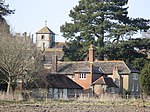Rock Mill, Washington
Grade II listed buildings in West SussexGrade II listed windmillsOctagonal buildings in the United KingdomSmock mills in EnglandWindmills completed in 1823 ... and 1 more
Windmills in West Sussex

Rock Mill is a Grade II listed smock mill at Washington, West Sussex, England, which has been converted to residential use.
Excerpt from the Wikipedia article Rock Mill, Washington (License: CC BY-SA 3.0, Authors, Images).Rock Mill, Washington
The Hollow,
Geographical coordinates (GPS) Address Nearby Places Show on map
Geographical coordinates (GPS)
| Latitude | Longitude |
|---|---|
| N 50.9117 ° | E -0.3966 ° |
Address
The Hollow
RH20 3DA
England, United Kingdom
Open on Google Maps









